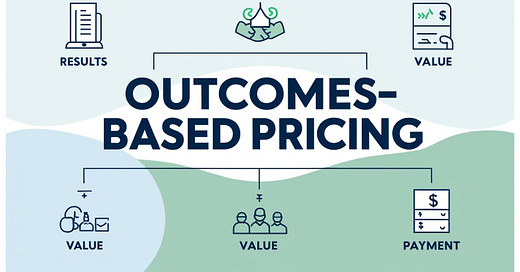Outcomes Based Pricing (Edition 16)
Outcomes based pricing is becoming a hot topic. Is it something that Sales teams should consider leveraging? This post lists out a few scenarios under which it could make sense.
There is an increasing amount of talk about ‘Outcomes based pricing’ these days. Or ‘Service as a Software’.
Both these phrases are related, but what exactly are these?
Both of these phrases refer to a model where the vendors focus on delivering results (aka outcomes) to a customer. Whereas ‘Outcomes based pricing’ refers to how pricing gets structured under these models, ‘Service as as Software’ is all about the delivery structure of this model.
Now, if you are a Sales leader, should you be considering outcomes based pricing for the purchases that you make? (I assume offering your product with this model is more of a product/executive decision, so I will skip discussing that.)
I believe you should be. In certain scenarios.
The quantitative nature of sales goals (“Get me $X million revenue this year, Mr. CRO!”) implies that sales can lend itself well to pricing focused on outcomes. However, it could backfire in many situations, so one should consider it carefully.
Which outcomes should sales teams measure? I think the answer to that is easy. It should be the same KPI by which your team is measured today. For an AE team, it would almost always be Closed/Won revenue. For an SDR/BDR team, it would usually be pipeline.
While other KPIs could be used, I believe these are the most effective KPIs to use. This is what all businesses need and want, and any product that delivers either of these will be seen as a needle-mover in everyone’s eyes.
However, I don’t think a lot of teams are yet ready to experiment with such pricing models. Here are a few factors that can define success/failure.
You can only measure what you have been measuring for a while. And measuring properly.
If you have not been measuring a KPI ‘properly’ for some time, it means you have no baseline to compare against. That makes measuring the impact of a new product hard.
An alternate method could be to use test/control groups structure as is often done for statistical studies. However, even such groups require the presence of a good measurement mechanism and instrumentation, and that will likely be there only if you have been doing it previously.
Hence, unless you are an organization that is already good at measuring its outcomes, it will probably not be a good idea to consider outcomes based pricing models yet.
My experience also shows that larger organizations - enterprises, publicly listed companies are usually good at having good measurement processes and instrumentation in place. It means that SMBs and mid-market companies should probably avoid considering outcomes based pricing.
One exception to this can be a vendor that has built measurement of such outcomes in its product itself. In the CX space for example, a company called Afiniti has been offering such measurability for close to 10 years now. At Humantic AI, we are probably one of the first Sales AI tools to build such measurability in the product itself.
For buyers, outcomes based pricing is likely to be more expensive. However, it is also significantly less risky, and that is what makes it an attractive possibility.
For the vendors, the reverse is true. It is a high-risk strategy, but it can potentially bring in a lot more revenue. Hence if you are confident in the value that your product delivers, this could be a risky but attractive option to consider and offer.
A high-quality Rev Ops team will likely be a necessity to ensure that outcomes based pricing works without creating too many complications. Hence you should focus on getting such a Rev Ops team in place before you decide to consider outcomes based pricing.
Outcomes based pricing will also face more scrutiny from the CFO’s office. Especially if it becomes successful. While the sales leadership will be praised for mitigating risk when a tool doesn’t work out, more questions will come, ironically, when your decision to bring in a certain tool/vendor leads to success. Hence it is important to collaborate closely with the CFO’s office and agree on a mutually acceptable plan before embarking on such a journey.
Where possible, it could be a good idea to have caps and limits in place. In case a tool/AI becomes ‘too’ successful, it would ensure that you are not piling on expenses that can create internal friction and lead to unnecessary questions. It is quite likely that vendors would seek assured revenue and lower limits in such cases, so such ‘range bound’ pricing could be considered.
At Humantic AI, we already offer outcomes based pricing optionally. We have decided to build measurability in the product itself - instead of putting the burden on the customer. Right now, it requires some manual work, but very soon, we will start offering a pre-built module that will measure deal progress through the stages as well as the win/loss rates, tie it to the use/non-use of Humantic AI product and clearly measure the change that occurs when Humantic AI is used.
Summary
While ‘Outcomes based pricing’ seems like an alien concept, Sales teams should actively consider adopting it under the right circumstances. There are powerful innovations occurring in the Sales AI space, decoupling the adoption of such innovations from budgetary constraints can give sales teams bigger wings to fly. Relative ease of seeing its impact on a measurable KPI in revenue makes it easier to adopt such an approach compared to many other functions where such quantitative KPIs might be more rare.




